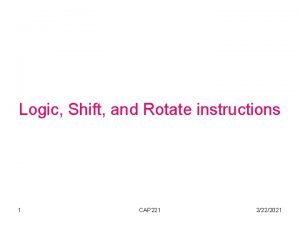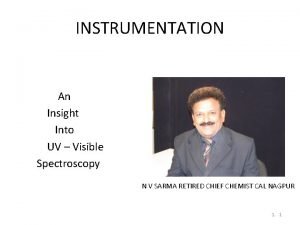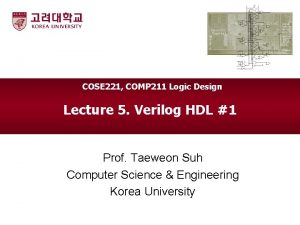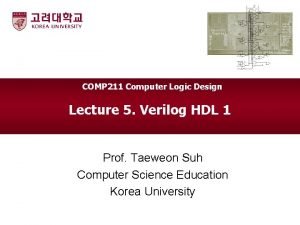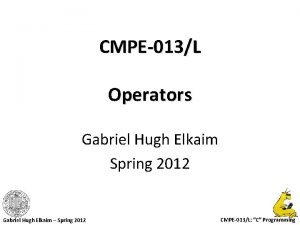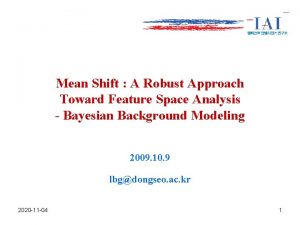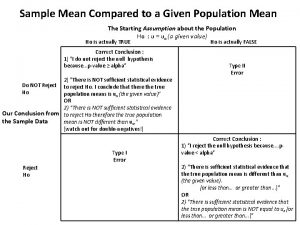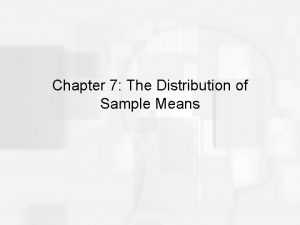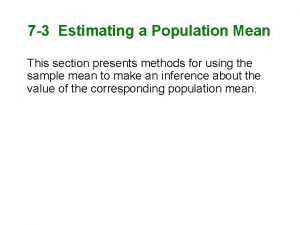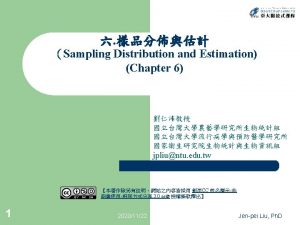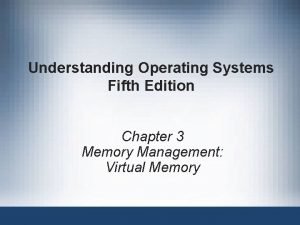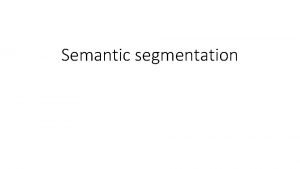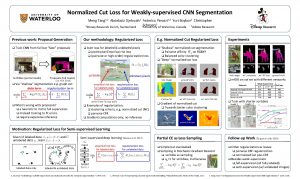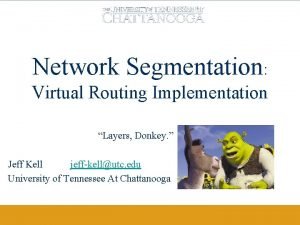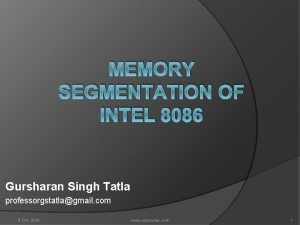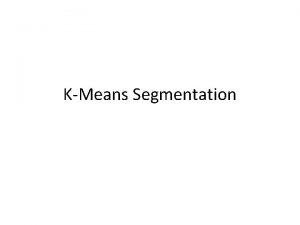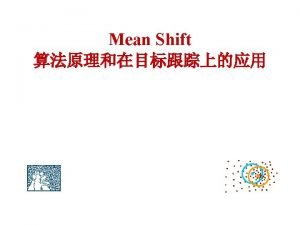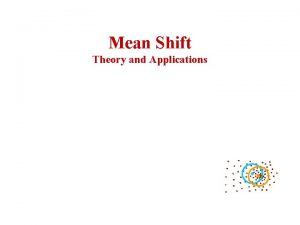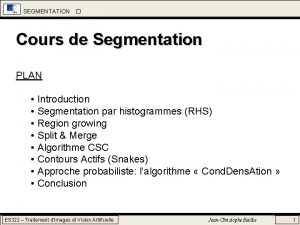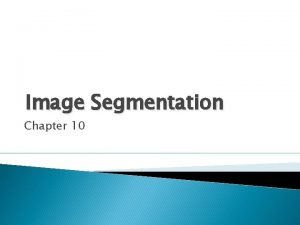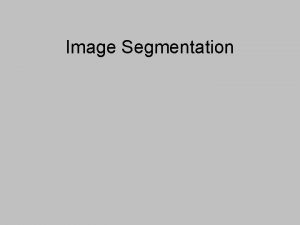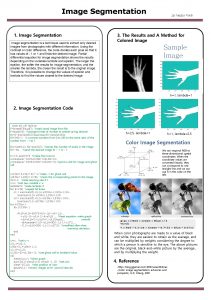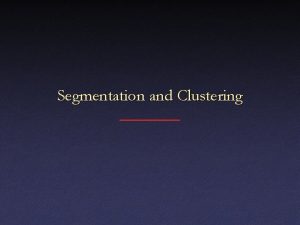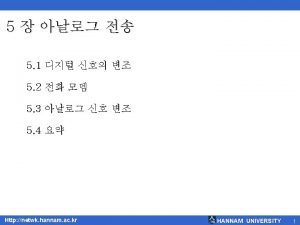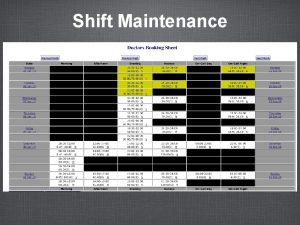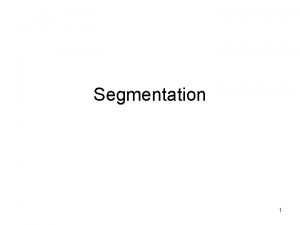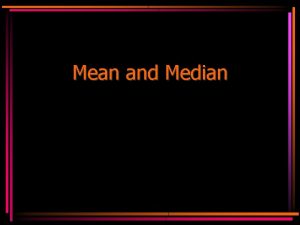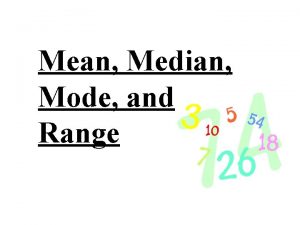Mean shift Mean shift or segmentation in general
























































- Slides: 56

Mean shift

Mean shift (or segmentation in general) Why? To find “chunks” of image that have meaning possibly objects Because pixels are too small to work with individually and most pixels are like their neighbors To compress the image

Mean shift example

Examples of mean shift segmentation:

Examples of mean shift segmentation:

Mean shift definition • Mean shift is a feature-space analysis technique for locating the maxima of a density function. • Originally presented in 1975 by Fukunaga and Hostetler. • Mean shift is used for various purposes like image processing, computer vision.

Mean shift definition - continue • The basic idea of mean shift: • Given a collection of n points, we want to separate the points into regions by finding the densest regions. • In other words, we want to be able to locate each point to its region. • In images, the points are actually pixels. We use mean shift algorithm to separate the image into regions.

הדגמה Region of interest Center of mass Mean Shift vector 8

הדגמה Region of interest Center of mass Mean Shift vector 9

הדגמה Region of interest Center of mass Mean Shift vector 10

הדגמה Region of interest Center of mass Mean Shift vector 11

הדגמה Region of interest Center of mass Mean Shift vector 12

הדגמה Region of interest Center of mass Mean Shift vector 13

הדגמה Region of interest Center of mass 14

Mean shift – 1 D density example

Mean shift – using density function • We want to represent all discrete points into a dense function so that we can calculate the maxima of the function around each point (and by that, to find the densest area around the point). • Since we want to calculate the derivative of the density function (in 1 D points) or the gradient of the function (in 2 D points) we must convert the points into a density function.

Mean shift – kernel function Let’s define density function p(x) which uses the kernel function K(x). P(x) – x is coordinate point K(x) – x is the distance of a given point.


KERNEL של סוגים o Uniform

KERNEL של סוגים o Epanechnikov


Density function • Source: http: //luthuli. cs. uiuc. edu/~daf/courses/CS-498 -DAF-PS/Segmentation. pdf

Mean shift – 1 D density example uniform kernel

Mean shift – 2 D density example uniform kernel Calculating p(x) for the center of the circle (h=1): There are 18 points in the circle. 12 points outside the circle. 30 points all together. By the kernel function we’ll count 0. 5 18 times, and in the rest we’ll count 0. We get a number close to 0. 5 which is the biggest number that p(x) can get.

Mean shift – 1 D density example Epanechnikov kernel

Mean shift – 1 D density example normal (gaussian) kernel

Mean shift – h Which maxima to go?

Depends on h h

Depends on h h

H window The h window should be big enough to find significant mode (we don’t want to locate the red point into the gray point. Too small maxima). And the h window should not be too big (so that all the points will converge into both peaks and not only one of them).

Finding a maximum • Source: http: //luthuli. cs. uiuc. edu/~daf/courses/CS-498 -DAF-PS/Segmentation. pdf

Finding a maximum - continue • Source: http: //luthuli. cs. uiuc. edu/~daf/courses/CS-498 -DAF-PS/Segmentation. pdf

Finding a maximum - continue • Source: http: //luthuli. cs. uiuc. edu/~daf/courses/CS-498 -DAF-PS/Segmentation. pdf

Finding a maximum - continue • Source: http: //luthuli. cs. uiuc. edu/~daf/courses/CS-498 -DAF-PS/Segmentation. pdf

m(x)=Mean shift vector

Finding a maximum - continue Translating the kernel window by the mean shift vector is guaranteed to converge at a nearby point where the density function has zero gradient. Basin of attraction – the set of all locations that converge to the same mode define the basin of attraction. Source: http: //luthuli. cs. uiuc. edu/~daf/courses/CS-498 -DAF-PS/Segmentation. pdf

We want to move the green point to the center of the densest area around it. We’ll call the function above. 37

Calling again the function. The point getting closer to the densest area. 38

Calling the function again. The point is at the densest area. Or closer than a threshold defined ahead. 39

H window – 2 D The window h should also be big enough to prevent saddle point (in 2 D points).

Finally images!!


Mean shift on images Smoothing through replacing the pixel in the center of a window by the weighted average of the pixels in the window indiscriminately blurs the image, removing not only the noise but also salient information. Using mean shift filtering reduces the amount of smoothing near abrupt changes.

Mean shift on images If p is the color dimensions of an image (1 if the image is grayscale and 3 in case of color image). d=p+2 is the image dimensions (2 for x, y pixels locations). In images each pixel has d-dimensional vector of information.

Mean shift in images - continue •

Mean shift filtering algorithm •

Mean shift filtering - example

Mean shift - images Mean shift based filtering for gray-level data. a – input b – mean shift paths for the pixels in the white rectangle marked in the picture. The black dots are the points of convergence.

Mean shift images - continue


Mean shift image segmentation •

Mean shift image segmentation – example (cameraman again) d – segmented result

Image segmentation example

Mean shift segmentation - example

sources • Segmenting images and mean shift by D. A Forsyth. • Introduction To Mean Shift Algorithm (https: //saravananthirumuruganathan. wordpress. com/2010/04/01/introduction-to-mean-shiftalgorithm/) by Saravanan Thirumuruganathan. • Mean Shift: A Robust Approach Toward Feature Space Analysis by Dorin Comaniciu, Member, IEEE, and Peter Meer, Senior Member, IEEE

THE END!!
 Mean shift segmentation
Mean shift segmentation Mean shift segmentation
Mean shift segmentation Allowed electronic transition
Allowed electronic transition Bathochromic shift and hypsochromic shift
Bathochromic shift and hypsochromic shift Difference between arithmetic shift and logical shift
Difference between arithmetic shift and logical shift Bathochromic shift and hypsochromic shift
Bathochromic shift and hypsochromic shift Difference between arithmetic shift and logical shift
Difference between arithmetic shift and logical shift Difference between arithmetic shift and logical shift
Difference between arithmetic shift and logical shift Gabriel hugh elkaim
Gabriel hugh elkaim Difference between arithmetic shift and logical shift
Difference between arithmetic shift and logical shift Mandible movement
Mandible movement Mean shift: a robust approach toward feature space analysis
Mean shift: a robust approach toward feature space analysis Planos en cinematografia
Planos en cinematografia Where did general lee surrender to general grant?
Where did general lee surrender to general grant? Mean of population vs sample
Mean of population vs sample متوسط الانحراف المطلق للبيانات
متوسط الانحراف المطلق للبيانات Difference between mean and sample mean
Difference between mean and sample mean How to find population mean
How to find population mean Mean of the sampling distribution of the sample mean
Mean of the sampling distribution of the sample mean What does mean mean
What does mean mean Define mean deviation
Define mean deviation Says means matters
Says means matters Market segmentation images
Market segmentation images Demand paged memory allocation
Demand paged memory allocation Demographic segmentation of tesla
Demographic segmentation of tesla Strategie das
Strategie das Granité stercoral
Granité stercoral Sku rationalization
Sku rationalization Clement farabet
Clement farabet Market segmentation template
Market segmentation template Market segmentation and targeting ppt
Market segmentation and targeting ppt Marketing strategy segmentation targeting positioning
Marketing strategy segmentation targeting positioning Southwest airlines
Southwest airlines Nivea positioning statement
Nivea positioning statement Requisites of market segmentation
Requisites of market segmentation Determinant gap map
Determinant gap map Segmentation ciblage positionnement
Segmentation ciblage positionnement Segment routing
Segment routing Censydiam
Censydiam Pringles target demographic
Pringles target demographic Virtual memory
Virtual memory Normalized cut loss for weakly-supervised cnn segmentation
Normalized cut loss for weakly-supervised cnn segmentation Bases of market segmentation
Bases of market segmentation Normalized cut loss for weakly-supervised cnn segmentation
Normalized cut loss for weakly-supervised cnn segmentation Vrf segmentation
Vrf segmentation Mosaic postcode analysis
Mosaic postcode analysis Health insurance market segmentation
Health insurance market segmentation 8086 memory size
8086 memory size Segmentation du marché exemple
Segmentation du marché exemple Age and life cycle segmentation
Age and life cycle segmentation Market segmentation is the process of dividing
Market segmentation is the process of dividing Market segmentation process
Market segmentation process Benefits of market segmentation targeting and positioning
Benefits of market segmentation targeting and positioning Requirements for effective segmentation
Requirements for effective segmentation Positioning methods
Positioning methods Concentrated targeting
Concentrated targeting Segmentation levels
Segmentation levels




